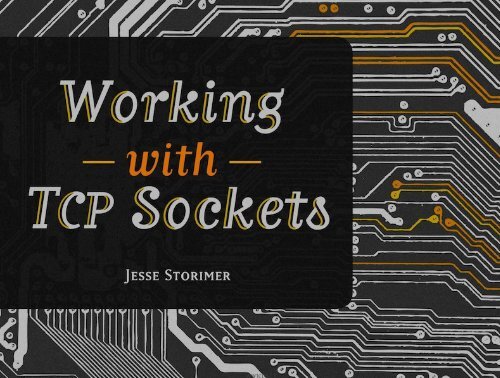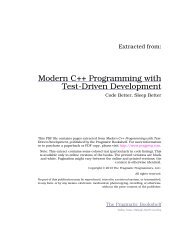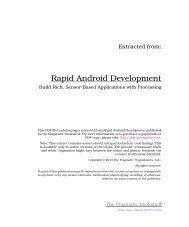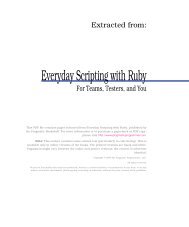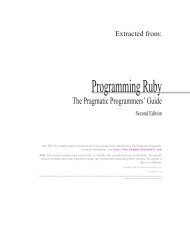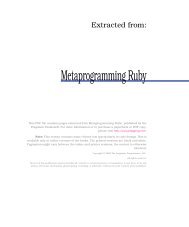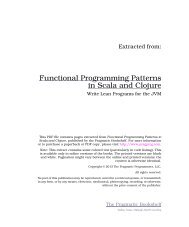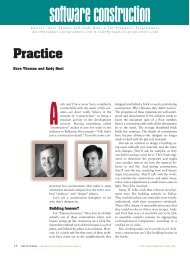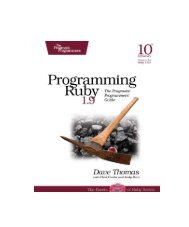Process per connection
Process per connection
Process per connection
You also want an ePaper? Increase the reach of your titles
YUMPU automatically turns print PDFs into web optimized ePapers that Google loves.
Working With TCP SocketsCopyright (C) 2012 Jesse Storimer.wwtcps | 2
Chapter 21<strong>Process</strong> <strong>per</strong> <strong>connection</strong>This is the first network architecture we'll look at that allows parallel processing ofrequests.ExplanationThis particular architecture requires very few changes from the serial architecture inorder to add concurrency. The code that accepts <strong>connection</strong>s will remain the same, aswill the code that consumes data from the socket.The relevant change is that after accepting a <strong>connection</strong>, the server will fork a childprocess whose sole purpose will be the handling of that new <strong>connection</strong>. The childprocess handles the <strong>connection</strong>, then exits.wwtcps | 142
Forking BasicsAny time that you start up a program using $ ruby myapp.rb , for instance, a newRuby process is spawned that loads and executes your code.If you do a fork as part of your program you can actually create a new process atruntime. The effect of a fork is that you end up with two processes that are exactcopies. The newly created process is considered the child; the originalconsidered the parent. Once the fork is complete then you have two processesthat can go their separate ways and do whatever they need to do.This is tremendously useful because it means we can, for instance, accept a<strong>connection</strong>, fork a child process, and that child process automatically gets a copyof the client <strong>connection</strong>. Hence there's no extra setup, sharing of data, or lockingrequired to start parallel processing.Let's make the flow of events crystal clear:1. A <strong>connection</strong> comes in to the server.2. The main server process accepts the <strong>connection</strong>.3. It forks a new child process which is an exact copy of the server process.4. The child process continues to handle its <strong>connection</strong> in parallel while the serverprocess goes back to step #1.wwtcps | 143
Thanks to kernel semantics these processes are running in parallel. While the newchild process is handling the <strong>connection</strong>, the original parent process can continue toaccept new <strong>connection</strong>s and fork new child processes to handle them.At any given time there will always be a single parent process waiting to accept<strong>connection</strong>s. There may also be multiple child processes handling individual<strong>connection</strong>s.wwtcps | 144
Implementationwwtcps | 145
equire 'socket'require_relative '../command_handler'# ./code/ftp/arch/process_<strong>per</strong>_<strong>connection</strong>.rbmodule FTPclass <strong>Process</strong>PerConnectionCRLF = "\r\n"def initialize(port = 21)@control_socket = TCPServer.new(port)trap(:INT) { exit }enddef gets@client.gets(CRLF)enddef respond(message)@client.write(message)@client.write(CRLF)enddef runloop do@client = @control_socket.acceptpid = fork dorespond "220 OHAI"handler = CommandHandler.new(self)loop dorequest = getswwtcps | 146
if requestrespond handler.handle(request)else@client.closebreakendendend<strong>Process</strong>.detach(pid)endendendendserver = FTP::<strong>Process</strong>PerConnection.new(4481)server.runAs you can see the majority of the code remains the same. The main difference is thatthe inner loop is wrapped in a call to fork .@client = @control_socket.accept# ./code/ftp/arch/process_<strong>per</strong>_<strong>connection</strong>.rbpid = fork dorespond "220 OHAI"handler = CommandHandler.new(self)Immediately after accept ing a <strong>connection</strong> the server process calls fork with a block. Thenew child process will evaluate that block and then exit.wwtcps | 147
This means that each incoming <strong>connection</strong> gets handled by a single, independentprocess. The parent process will not evaluate the code in the block; it just continuesalong the execution path.<strong>Process</strong>.detach(pid)# ./code/ftp/arch/process_<strong>per</strong>_<strong>connection</strong>.rbNotice the call to <strong>Process</strong>.detach at the end? After a process exits it isn't fully cleaned upuntil its parent asks for its exit status. In this case we don't care what the child exitstatus is, so we can detach from the process early on to ensure that its resources arefully cleaned up when it exits 2 .ConsiderationsThis pattern has several advantages. The first is simplicity. Notice that very little extracode was required on top of the serial implementation in order to be able to servicemultiple clients in parallel.A second advantage is that this kind of parallelism requires very little cognitiveoverhead. I mentioned earlier that fork effectively provides copies of everything a childprocess might need. There are no edge cases to look out for, no locks or race conditions,just simple separation.An obvious disadvantage to this pattern is that there's no up<strong>per</strong> bound on the numberof child processes it's willing to fork. For a small number of clients this won't be anissue, but if you're spawning dozens or hundreds of processes then your system will2. If you want to learn more about process spawning and zombie processes then you should get my other book Working WithUnix <strong>Process</strong>es.wwtcps | 148
quickly fall over. This concern can be solved using the Preforking pattern discussed afew chapters from now.Depending on your o<strong>per</strong>ating environment, the very fact that it uses fork might be anissue. fork is only supported on Unix systems. This means it's not supported on Windowsor JRuby.Another concern is the issue of using processes versus using threads. I'll save thisdiscussion for the next chapter when we actually get to see threads.Examples• shotgun• inetdwwtcps | 149


